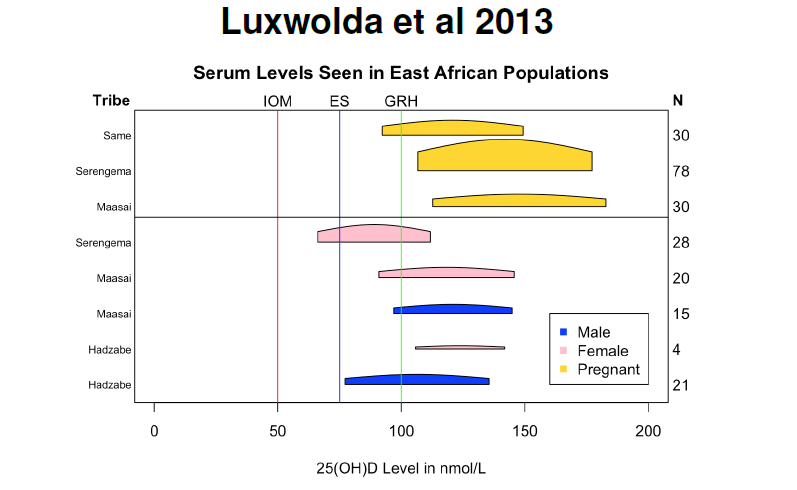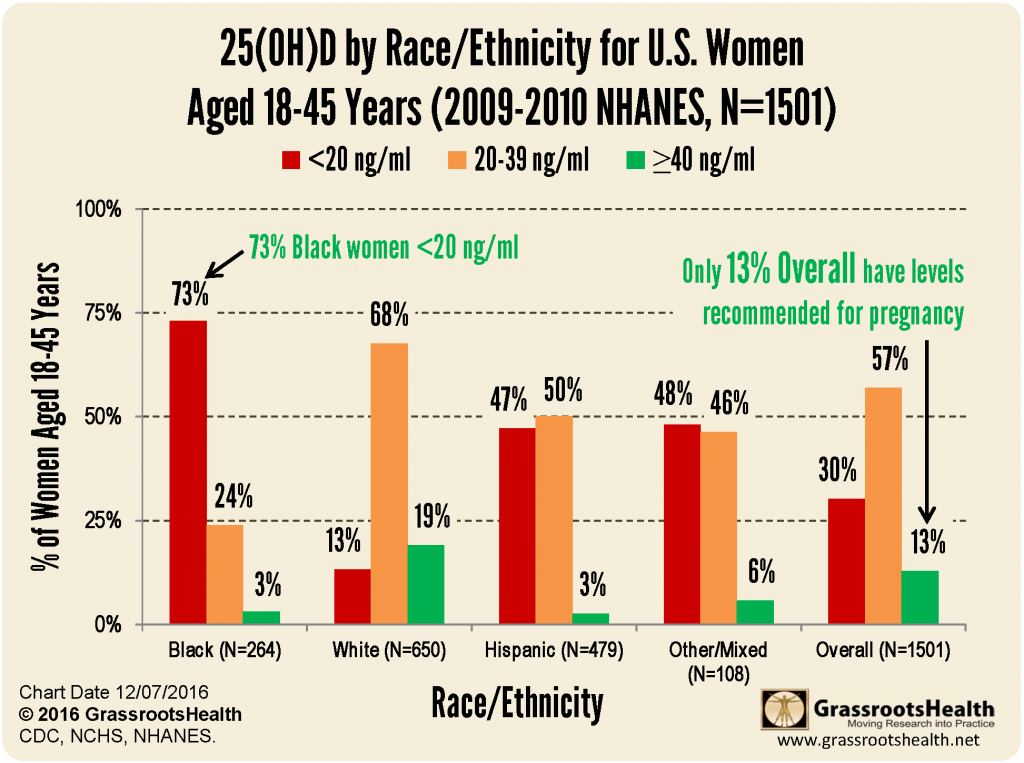Published on June 14, 2017
Safe and Effective
Since 2011, researchers in South Carolina have shown that vitamin D serum levels of 40-60 ng/ml (100-150 nmol/L) during pregnancy are safe and effective.
Safe – no kidney stones, no hypercalcemia, no adverse effects.
Effective – they tested vitamin D blood levels (25(OH)D) and typically raised it above 40 ng/ml (100 nmol/L) which later became their target. No one in the trials reached a level above 150 ng/ml (considered potentially unsafe).
Nature’s Intention? – Vitamin D researchers have looked at tribal cultures to see what vitamin D levels occur naturally with outdoor living (and no sunscreen). They found that typical levels are around 46 ng/ml AND that in during pregnancy vitamin D levels are even higher. Could it be that nature knows that mothers need more vitamin D during pregnancy – for both themselves and their growing baby?

Why do we need to test?
Research has shown that almost all African American women of childbearing age, and 80% of all women have vitamin D levels less than 40 ng/ml. This means it is highly likely you are too. It is not enough to just supplement because you do not know how much your body needs. Our D*action project, with over 10,000 participants, has found that there is a 6-fold variation in how much is processed by your body. Our research has found that people taking 5,000 IU per day can end up with levels of only 25 ng/ml or as high as 140 ng/ml. It’s important to measure your blood serum levels because supplementing shows up vastly different for everyone.
What are the outcomes?
Some staggering numbers, which all have research behind them, for mothers with vitamin D levels of at least 40 ng/ml.
1. Greater than 50% lower risk of preterm birth (compared to those with levels less than 20 ng/ml), more if you have a history of preterm birth or are African American.
2. Virtually eliminates pre-eclampsia.
3. Lower risk of gestational diabetes.
4. Lower risk of post-partum depression.
For the child
1. 70% lower prevalence of common cold.
2. 66% lower prevalence of ear infections.
3. Improved language development.
4. Reduction of type 1 diabetes (in adulthood).
Think of it this way… if you are pregnant, your baby is developing from your stores, your nutrient status. If your body has the nutrient building blocks available, then your body can build the best possible outcome.
Another nutrient which has a total body effect is folic acid (folate). This nutrient significantly affects brain development which occurs in the early weeks of development – sometimes before a woman knows she is pregnant. Folic acid has significantly reduced neural tube defects since its introduction in the late 1990s. BUT, it took 30 years to ensure it was recommended to all pregnant women.
Think of yourself as informed now – you can start now – don’t wait the 30 years it will take the establishment to catch up. Vitamin D has a drastic effect on all stages of a baby’s development – so have your vitamin D stores replete and ready for use.
Act now!
If you or someone you know is having children, let them know this information as soon as possible. Get a blood test from your doctor or by joining D*action for pregnancy. If you are between 12-17 weeks pregnant you may join for free. If you are pregnant and outside that timeframe, join our overall D*action project.
Read all you can about vitamin D and keep your blood level above 40 ng/ml (100 nmol/L). This might require a few tests before you find out what works for you. Wait 2-3 months after changing your vitamin D regimen (more sun or supplement) before you re-test.
Need backup? For your OB…
When You’re Expecting Twins, Triplets or Quads – Proven Guidelines for a Healthy Multiple Pregnancy, by Barbara Luke, Tamara Eberlein, and Dr. Roger B. Newman is a great resource for vitamin D and pregnancy. Dr. Newman helped update the latest edition and added information about vitamin D and the stages of pregnancy. Even if you are not having multiples – this is a great resource.
Want to read the research, or download handouts and infographics? Go here.

